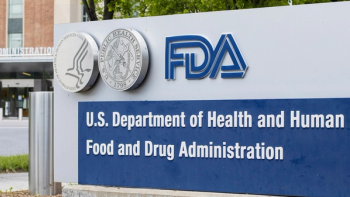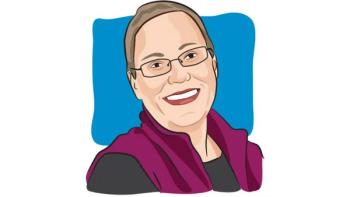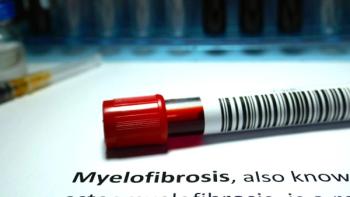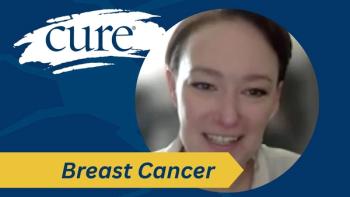Adjuvant treatment with Alecensa (alectinib) elicited a 4-year overall survival (OS) rate of 98.4% for patients with resected ALK-positive early stage non–small cell lung cancer (NSCLC) according to an updated analysis of the phase 3 ALINA study presented at the 2025 ESMO Congress.
At a median of 48 months of follow-up in the Alecensa arm (130 patients) and 47.4 months in the chemotherapy arm (127 patients), the 4-year OS rate was 92.4% in the comparator chemotherapy group; however, 81.7% of patients in this arm had received a subsequent ALK inhibitor after recurrence, including 58.3% who received Alecensa. The hazard ratio for OS between the two arms was 0.4. The 4-year disease-free survival (DFS) rate was 75.5% with Alecensa compared with 47% with chemotherapy, and the median DFS was not evaluable versus 41.4 months, representing a 65% reduction in the risk of disease recurrence or death.
"This slide may give you impression that you are in the wrong room. No, this is not a breast cancer session," lead investigator Dr. Rafal Dziadziuszko from the Medical University of Gdansk in Poland joked when showing the slide for OS. "This is a lung cancer session which we hoped for so many years. This is due to the activity of Alecensa and also activity of ALK inhibitors in post-chemotherapy setting in those patients who relapsed."
How was the ALINA study designed?
In the ALINA study, patients were randomly assigned one-to-one to receive adjuvant Alecensa or platinum-based chemotherapy following the surgical resection of their ALK-positive NSCLC. Alecensa was administered twice daily at 600 milligrams for two years and chemotherapy was given every three weeks for four cycles.
Glossary
Adjuvant treatment: therapy given after surgery to lower the risk of the cancer returning.
ALK-positive: describes lung cancer cells with a change in the ALK gene, which drives cancer growth and can be targeted by drugs like Alecensa.
Overall survival (OS): time from treatment start or surgery until death from any cause.
Disease-free survival (DFS): time after treatment during which a patient shows no signs of cancer.
Lobectomy: surgery that removes one section (lobe) of the lung containing the tumor.
ECOG performance status: scale used by doctors to measure how well a patient can perform daily activities.
Investigator-assessed DFS in the intention-to-treat population (comprising patients with stage 1B to 3A disease) as well as the subgroup of patients with stage 2 to 3A disease served as the primary end point. Central nervous system (CNS) DFS and OS were secondary end points.
Baseline patient characteristics were balanced between the arms with patients being slightly younger than in other studies of lung cancer. In the Alecensa group, 79% of patients were below the age of 65 and 65% were never smokers. The ECOG performance status was 0 (55%) and 1 (45%) and the most common stage at diagnosis was 3 (53%). N2 status was seen in nearly half of patients (49%) and most had nonsquamous histology (95%). Lobectomy was the most utilized surgical procedure (97%).
Following recurrence, 24 of 31 patients in the Alecensa arm (77.4%) and 55 of 60 in the chemotherapy arm (91.7%) received a subsequent therapy. For the chemotherapy group, 81.7% of these treatments were ALK inhibitors with 61.3% of patients receiving a subsequent ALK inhibitor in the Alecensa arm. For Alecensa, 29% of patients received subsequent chemotherapy. Radiotherapy was used for 25.8% of those in the Alecensa arm following recurrence and for 16.7% in the chemotherapy arm.
What additional data were reported in the long-term ALINA analysis?
For patients specifically with stage 2 through 3A disease, the DFS rate at 4 years was 74.5% with Alecensa compared with 46.3% with chemotherapy; the median DFS was not evaluable and 41.4 months respectively. DFS favored Alecensa across all subgroups including for stages, nodal status and race, Dziadziuszko noted.
The CNS DFS was also improved with Alecensa in the ITT population with a 63% reduction in the risk of this event occurring with the ALK inhibitor. The 4-year CNS DFS rate was 90.4% with Alecensa compared with 76.1% with chemotherapy.
"This is an important end point since ALK-positive disease has a predominance for brain dissemination," said Dziadziuszko.
Side effects were similar to prior assessments of the study, said Dziadziuszko. In the label, the most common side effects were hepatotoxicity, constipation, myalgia, COVID-19, fatigue, rash and cough.
"Alecensa continues to demonstrate a robust and durable disease-free survival benefit over chemotherapy with a hazard ratio that is consistently below 0.4 and also benefiting the reduction of risk of CNS recurrence," Dr. Marcello Tiseo, Department of Medicine and Surgery at the University of Parma in Italy, said during a discussion of the results. "OS data are still immature but the magnitude and durability of DFS improvement coupled with a well-tolerated safety profile reinforce Alecensa as a standard of care for resected ALK-positive NSCLC."
In reference to the OS data, Tiseo proposed more work should be done to examine the duration of therapy as many of the progression events occurred only after treatment was stopped at two years. "The 4-year OS [rate] of [98.4]% and in particular the trend toward improvement in OS despite [most] patients receiving a TKI at recurrence suggests the possibility of curing these patients," he said.
Based on an earlier assessment of the ALINA trial, the FDA approved adjuvant Alecensa for patients with ALK-positive NSCLC in April 2024. This approval was made under the FDA's Project Orbis initiative, the Real-Time Oncology Review program and Assessment Aid, each designed to help expedite impactful treatments for patients. The approval was granted one month ahead of schedule.
References
- “Updated results from the phase 3 ALINA study of adjuvant Alecensa versus chemotherapy in patients with early-stage ALK-positive non-small cell lung cancer” by Dr. Rafal Dziadziuszko, et al., ESMO Congress
- “FDA approves Alecensa as adjuvant treatment for ALK-positive non-small cell lung cancer” by Dr. Rafal Dziadziuszko, et al., FDA
For more news on cancer updates, research and education, don’t forget to subscribe to CURE®’s newsletters here.






